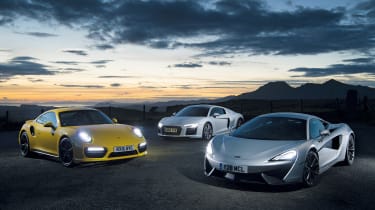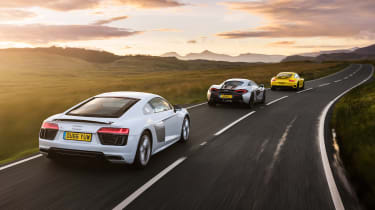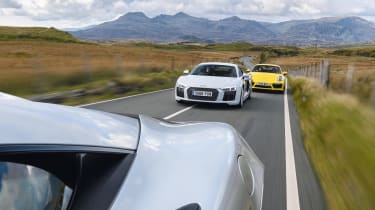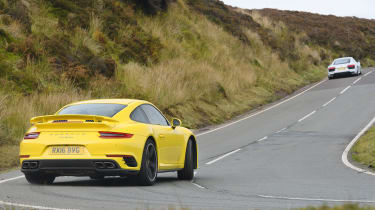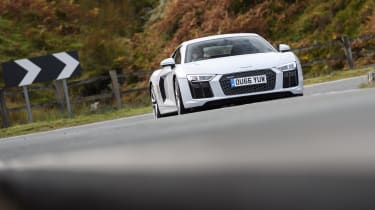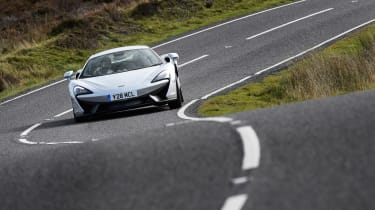McLaren 540C vs Porsche 911 Turbo vs Audi R8 review – ‘everyday’ supercar group test
Three perfectly matched ‘entry-level’ supercars, but can any of them step out from the shadow of their more esteemed siblings?
The McLaren 540C, Porsche 911 Turbo and Audi R8 V10 all have well over 500bhp, sub-four-second 0-60mph times and show-offy six-figure price tags, and yet each seems destined to be perceived as the slower, cheaper and humbler version. The one you buy when business has been slow, or the divorce settlement particularly brutal.
It’s all nonsense, of course, but when you’ve got the 570S, 911 Turbo S and R8 V10 Plus strutting about in the sunnier corner of the showroom, each of these three cars will only ever be marked down as the slightly underachieving younger sibling. Imagine the deep-seated feelings of inadequacy if they had hearts rather than pistons, and brains instead of ECUs.
The thing about an inferiority complex, though, is that it can either make a person bitter and anti-social, or it can stir something primal deep within and drive them into successes far beyond the reach of their seemingly more illustrious siblings. In the case of one of these second-tier supercars, that’s exactly what has happened. But that won’t decide the winner of this group test. The victor will be the car that delivers the purest, most concentrated driving thrill, because – as supercars – that’s what they must do above all else.
For what might be the first time in an evo triple test, every one of these cars produces exactly the same power: 533bhp. And their top speeds are all within a whisker of each other. The McLaren tops out at 199mph, while the Audi and Porsche plod along at 198mph. All three cost in the order of £125,000.
McLaren Automotive might be the newcomer, but as a brand it already has more aspirational currency than either Audi or Porsche. Appropriately, it’s the McLaren that feels the most exotic of the trio with its carbonfibre tub and hawkish styling. It helps, too, that the 540C sits at the bottom of a very prestigious model range and is illuminated by the glow of the more expensive models as a result, whereas the R8 and 911 sit somewhere near the top of their manufacturers’ ranges and are tasked with brightening the more mundane cars beneath them.
The 540C’s engine is a 3.8-litre twin-turbo V8, which revs beyond 8000rpm despite its forced induction. These Sports Series McLarens are designed to be more useable every day than Woking’s more focused efforts, lowered sills being one of several attempts to make the car less of a hassle in daily use. Compared with its rivals, though, the 540C is still quite tricky to get into and out of.
The sculptural cabin looks good and the seating position is absolutely superb – McLaren consistently does this better than anybody else – but the information and entertainment systems and minor controls just aren’t as intuitive as the R8’s or 911’s. This might be the everyday McLaren, but the German cars ask their drivers to make far fewer allowances and concessions.
The least demanding car here in the day-to-day grind is the Porsche, and by some margin. Those little rear seats aren’t much use for anyone over the age of seven, but they can be used as valuable storage space, whereas the McLaren and Audi limit you to rather mean compartments between the front wheels. The 911 also has one of those, of course. But that's just a small part of what makes the Turbo so unfussy. It flops over speed bumps like a saloon car and visibility from inside the cabin is as good as a hatchback’s. It’s also quiet, you don’t worry so much about where you leave it and it turns far fewer heads, or at least it would in anything other than look-at-me yellow.
The 911 Turbo outsells the competition by an order of magnitude precisely because it’s so easy to use as an everyday car. Given that these slightly more affordable variants are much more likely to be an only car than the costlier models, themselves more often part of a fleet, that everyday-useability is perhaps as important a consideration as soundtrack or steering feel. The trade-off is that for sense of occasion it’s a rubbery pork chop in a flat-roofed pub to the McLaren’s filet mignon.
The 911 uses a 3.8-litre flat-six, also twin-turbocharged, but it doesn’t rev anywhere near as high as the McLaren’s V8. Instead, it’s a torque monster, its 524lb ft from 1950rpm somewhat showing up the 540C’s 398lb ft from 3500rpm. The Turbo is four-wheel drive, of course, and as with the other two cars it has a twin-clutch gearbox.
The Audi R8 is one of the last remaining naturally aspirated supercars, which is reason enough to throw petals and blow kisses at it as though it’s some returning space adventurer of the ’60s. The 5.2-litre V10 is far and away the most exciting engine of this lineup and with the same peak torque output as the McLaren, albeit arriving 3000rpm higher up the rev-range, it doesn’t give up a great deal in terms of straight-line shove.
The R8 feels very wide and visibility is good but not great, which means it doesn’t slip through town as effortlessly as the Porsche. The two are distant cousins, both with the weight of the world’s biggest car maker behind them, but inside the cabin it’s the R8 that seems to have benefited more from that vast R&D capability. Its cockpit is brilliant and the systems all have the polish and slickness of an Apple product. In just about every way you interact with the R8, it feels so completely modern.
540C vs 911 Turbo vs R8: on the road
We were pushing our luck coming to north Wales in the middle of winter but, a few spots of rain aside, the weather is holding up. I’d chosen the McLaren for the long drive from the office. I know very well that the other two would have made no fuss whatsoever of the four-hour trek, but while the long stint at its wheel has reminded me what a brilliant little supercar the 540C is, it hasn’t convinced me that it’s a consummate GT car. It’s noisier than the others on the motorway and the steering wheel fidgets constantly in your hands. If you could somehow measure the aspects of a car’s behaviour that most fatigue a driver, both of those things would be right at the top of the list. Far from finding the McLaren’s chattery steering an annoyance, though, I actually think it’s rather wonderful.
I love how tactile it is. I adore cruising along at half-pace down a gently winding road with an egg-shell finger-tip touch on the perfectly sized steering wheel, feeling it patter and tug, sensing the shape of the road beneath and the cambers and the ruts as the rim twists lightly this way and that. There’s some strange, indefinable joy in feeling connected to a machine, the interactions going back and forth. The important point, I think, is that you can enjoy that sense of connection even at low speeds. The 540C is not a car that needs to be slung from some great trebuchet before it comes to life.
The Audi and the Porsche both steer very differently to the McLaren (the Germans use electric power steering systems to the Brit’s hydraulic setup). This relates back to the R8, and to a slightly lesser extent the 911, feeling oh-so modern. In either car you can turn into a long corner and not feel a single chirrup from the steering wheel. All white noise has been digitally erased. There’s nothing, the steering wheel completely still. Refined, sophisticated, modern. In the analogue 540C that white noise is part of the track, a coarse texture. Sandpaper to silk.
There are certain cars whose steering absolutely should isolate you from the road surface the way the R8 and 911 do. But a supercar should dial you right in, steering wheel fidgeting away like a restless child. It’s a perfect example of automotive technology moving both forwards and back. The McLaren communicates beautifully through its steering; the Audi and Porsche do not. And so, in an effort to feel connected, you start to drive faster.
The 911 Turbo is the most upright car of three, but when you start to hurry it along a winding road it responds with the immediacy and control of a more conventional low-slung supercar. There is a fraction of lightness to the front end, but it doesn’t need to be managed in any way and the front axle finds just about as much turn-in bite as either of the mid-engined cars. The Turbo isn’t a pure point-and-squirt machine because you can brake deep and late to play with its balance, using the great mass hung out behind the rear axle to get the car to swing into a corner, and all within the constraints of the stability control. And then, away from a corner, you can either wait a fraction before pinning the throttle so that the car squats and fires itself forward, or open it up early and abruptly to overwhelm the rear tyres and get the thing sliding ever so slightly.
The Porsche will respond if you give it the right commands, but it’s a very narrow window. What’s frustrating is that the 911 Turbo does have this broad, expansive window of adjustability and playfulness, this strata in which you can make it dance around like a rally car, but it’s just a little beyond the reach of what’s acceptable on the public road. Strange as it may seem, the Turbo – the road-biased six-figure 911 – is actually a lot more fun on track.
A lot has been written about characterless modern turbocharged engines, not least in this magazine, but the 911 Turbo is excused from most of it. For one thing, the Turbo has always been turbocharged, so we aren’t dealing with a forced induction engine that’s replaced some wonderful naturally aspirated, high-revving motor (think new 911 Carrera). And, for another, Porsche’s engineers have allowed the Turbo to actually feel turbocharged – huge boost, a real rush of energy all the way to the red line – rather than trying to give it the linearity of an atmospheric engine. It all means the 911’s power unit is characterful and fun, as much a part of its overall make-up as the R8’s Screaming V10.
And my word does it thump the car down the road. For that shocking, dislocating sense of acceleration, nothing swings like a 911 Turbo at this money. Not even the Turbo S feels anymore brutal in a straight line. The PDK gearbox is instantaneous and responsive, too, which means the delays as upshifts slot in can scarcely be measured.
The Porsche is spectacularly quick on the road and that savage acceleration never grows old, but the truth is the Turbo isn’t the most rewarding or engaging car to drive quickly. You find yourself chasing it ever harder just to try and wake it up. That touch of aloofness is the counterpoint to its peerless everyday usability.
There is more to enjoy about the R8 at medium speeds – that mighty engine for one thing – and, like the 911, it draws you into driving it faster and faster. But whereas the Porsche goads you on and delivers only a little in reply, the Audi really does come to life.
In this specification it’s the only car here with fixed-rate dampers (adaptive dampers are an optional extra) and that does give it a slightly tauter ride than its rivals. This translates to excellent control and stability on a faster road, though, and with a little more wheel travel and slightly plusher tyre sidewalls on those 19-inch wheels, the car does squirm about a touch more than the V10 Plus model, which needs to be hustled before its chassis comes to life.
This test car has the much-maligned Dynamic Steering system, which does nothing to make the helm any more intuitive. The truth, though, is that the standard steering system isn’t really any better: a vague and slightly woolly rack that still takes time to develop any confidence in.
At speed, the R8 feels as though it has wide tracks and a short wheelbase, so it gives the impression of being square. It snaps into corners immediately and with no inertia. You have to edge up to its limits, though, rather than sensing them instinctively, but that doesn’t take long. It has balance, too, so you feel both axles working equally hard in corners. It’s not the most communicative or readable car here, but in time you get close to drawing every ounce of pace from it, corner after corner.
The gearbox is more responsive even than the Porsche’s and the V10 the most thrilling engine here, although without the optional sports exhaust the soundtrack is just a little flatter than it might be. And, wonderful as this engine is, it just isn’t as intoxicating as the 602bhp version that powers the V10 Plus. The red line comes in a little earlier and with every upshift you wish ever harder that you had the really hot motor behind you. The R8 V10 will always play a supporting role to the R8 V10 Plus.
The 540C not only steers better than its rivals; in just about every meaningful ride and handling discipline it leads the way. It’s the most enjoyable at lower speeds but also the most engaging and exciting with more commitment. You point it inch-perfectly into a bend, sense the chassis sit down and bite into the corner and, for an instant, you feel beautifully suspended between the two axles.
> Porsche 911 Turbo S | evo leaderboard
The 911 and R8 have a traction advantage, but I think the 540C is ultimately faster down a dry road because you can exploit all of its cornering and braking ability more of the time. You’re never left guessing or holding your breath and hoping. It backs up that predictability with massive grip and body control, and such fluid pliancy over bumps.
Switching the car into its Dynamic stability control setting soon becomes part of the start-up procedure. With the systems fully on, you can feel the car being restrained at every corner exit, as though being dragged backwards, but the Dynamic mode just released it a little.
What lets the McLaren down most is its engine. This is the least convincing version of the 3.8-litre V8 so far. It needs 3000rpm before it starts work and only above 5000rpm do you get the immediacy of response that you need to balance the car on the throttle away from an apex. Out of very tight corners you find yourself with the throttle wide open, just waiting for something to happen, even down in second gear.
Crucially, that’s not a frustration you often feel in the more responsive 570S. Rather like the R8, then, the cheaper, lower-powered version is shown up to be exactly that by its engine. And just as the R8 gazes up towards its more potent V10 Plus sibling, the 540C will always exist in the shadow of the 570S.
The 911 Turbo, then, is the only car here that makes its more expensive brother seem unnecessary. But, as we stated at the outset, that isn’t going to be enough to earn it the group test victory. Instead, that honour goes to the car that excites more than its rivals both at low and medium speeds and also when you’re hanging it over the edge. That honour goes to the only car here that truly makes you feel connected. It goes to the McLaren 540C.
